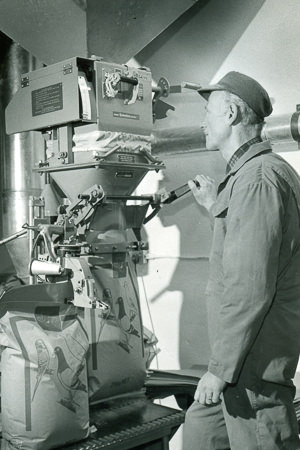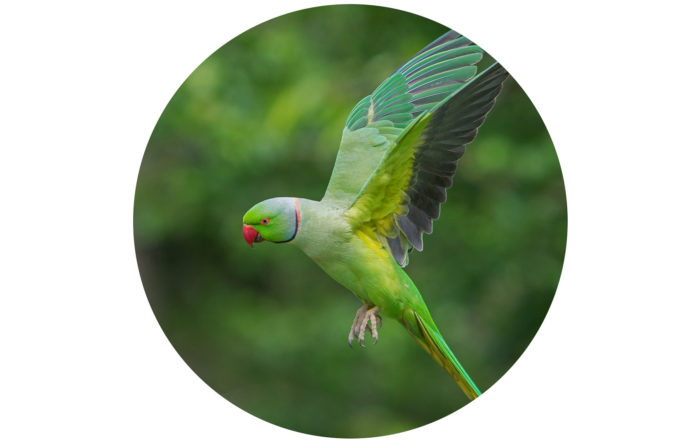How to Spot if Something is Wrong with Your Parrot – a Guide to Common Welfare Issues and Illnesses
As responsible pet owners, it’s our duty to ensure we provide top-notch care for our parrots.
This starts with basic duties such as feeding the right food at the right times, keeping their enclosure clean, spending time with your pet, and allowing them to get as much exercise as they need.
It also extends to monitoring the health of your bird, to make sure they live a long, healthy and happy life.
But this is where things can get more difficult. Parrots are extremely good at hiding any signs of illness and this is related to their behaviour in the wild. If they did so there, they would become more vulnerable to predators. Domestic parrots still exhibit the same traits.
Of course, that doesn’t help us in trying to care for these wonderful birds. That’s why we’ve put together this handy blog post, to help you learn a bit more about recognising the signs of illness in your parrot and finding the right support.
Behavioural Changes vs Physical Changes
When it comes to assessing your parrot’s health and wellbeing, there are two things you need to consider – changes in your bird’s physical condition and changes to their behaviour. Either one of these can mean your bird is in less than perfect health. Together, they may point to a really serious problem.
Of course, the better you know your parrot, the easier it is to pick up on out-of-the-ordinary behaviour, so make sure you spend lots of quality time with together. Carrying out some regular, basic health checks is also highly recommended too, to ensure you don’t miss any signs of illness.
Physical Changes
There are a number of physical changes a parrot can display which might suggest it is unwell. These can be quite subtle, because, as we mentioned, they’re masters of hiding symptoms. But over time you’ll learn to know what each little change means and get a better sense of how your pet is feeling. Use this sense to assess their health, and whether or not it is time for a visit to the vet.
Common physical changes to look out for include:
Feathers
Are your pet’s feathers ruffled? This maybe hiding weight loss which can soon become terminal for birds. Are they dirty because they’ve stopped preening? This is a classic sign something is amiss. Do the feathers look dull where they were once bright and shiny? This again, can be a sign of ill health.
Are there any signs of parasites? If the answer to any of these questions is yes, then monitor your pet’s feeding routine for a couple of days and check their droppings. If the situation doesn’t improve and you’re worried, take your parrot to the vet.
Red or Runny Cere or Eyes
The cere is bare, fleshy patch at the base of the upper part of the beak. It houses to the bird’s nostrils. Redness, inflammation or discharge from the cere can mean your bird has serious health problems and needs veterinary attention.
If your bird’s eyes are cloudy, red, or producing discharge, then veterinary attention may also be required as this could be due to respiratory, muscular or nervous disorder.
Grip Strength and Lower Limb Health
Good foot health is essential for the comfort of your bird as they will spend a significant amount of their day on a perch. If your bird is standing unevenly, or shuffling around when it wasn’t before, check its legs and feet. Are they moving freely without pain?
With smaller species of parrot, you can check grip strength on your finger, so try this. If you think there is a problem with your bird’s lower limbs, contact your vet.
Other Physical Changes to Watch Out For
The changes above tend to denote a serious health issues, but there are other checks you can do to ensure your parrot’s general state of health is okay.
Check inside your bird’s mouth to make sure it is clean they don’t have bad breath. Check the beak is in good condition with no fractures over overgrowth.
Generally, get to know your bird well and notice the little changes in their physical condition as this will be your best guide to their health. And as in all cases, if you’re concerned at all, consult a veterinary professional.
Behavioural Changes
Changes in your bird’s behaviour can be just as telling than physical changes when it comes to health. Again, recognising these comes down to knowing your bird well and understanding when they are acting differently to normal.
Sometimes this is a ‘gut feeling’ and even though you can’t put your finger on how your bird is acting differently, you just know that they are. Other times, it will be obvious. Whichever it is, if you’re worried, seek veterinary advice as it is better to be safe than sorry.
Here are some common behavioural changes to watch out for.
Loss of Appetite
Loss of appetite is a major concern for birds because they have a very high metabolism. This means they soon start to lose condition and weight.
Loss of appetite can be due to a blockage in the intestinal tract which can soon lead to a fatality, so if you bird is off their food, the best advice is to pay a visit to your vet.
Open Mouth Breathing
If you parrot is breathing with an open mouth while resting, that can be a sign of respiratory problems. Respiratory problems are common in parrots, but they are also serious.
If you see your parrot do this, immediately take them to see the vet as the chances are, if the condition has got to this stage, the bird has been ill for quite some time.
Tail Bobbing
Like open mouth breathing, tail bobbing is a sign of respiratory infections. This is because the muscles at the base of the tail help birds breathe by helping them to expand their lungs and take in air.
If the bird is short of breath, due to infection, those muscles will work harder causing the tail to bob up and down. So, if you see your parrot doing this, you’ve guessed it … it’s time to see the vet.
Changes is Mood and Vocalisations
As you get to know your bird, you’ll be able to read their mood and know how vocal they usually are. Any prolonged changes in these should set alarm bells ringing as they might be due to health issues.
There is always a degree of judgement required when considering your bird’s mood because moods are subjective and sometimes difficult to read. But if you are worried, checking with a vet as is always the best option.
Keep an Eye on your Bird’s Droppings
Okay, so this isn’t a behavioural change, but it is an important consideration, nonetheless. The most important things to watch out for are colour change, and a change in consistency. Although droppings will change colour a bit depending on different food types, watch for any yellow, rusty brown or tarry black colours as these might denote blood in the faeces.
Droppings that are too firm or too loose also can be a sign of illness too, so if your parrot shows this for longer than a day or too, seek professional advice.
Common Ailments to Look Out For
There are a number of diseases parrots suffer from that all owners need to be aware of. Although this is by no means an exhaustive list, what follows is a summary of the most common.
Psittacosis or Parrot Fever
Psittacosis is an extremely serious condition for parrots because most affected birds will die. It is caused by the Chlamydophia psittaci bacteria which can live in bird droppings or in the bird’s wider environment.
The condition can flare up in stressful situations and symptoms include conjunctivitis, depressed mood, ruffled feathers, loss of appetite and accompanying weight loss, loose droppings, breathing problems, nasal discharge and sneezing.
If your parrot is suffering from these symptoms, seek professional advice immediately. But beware. Sadly, because the condition is very difficult to treat and can be passed to humans, the vet may suggest putting the bird to sleep.
Aspergillosis
Aspergillosis is a fungal infection that affects parrots and other birds. It causes respiratory disease both to the upper respiratory tract, including the nose, sinuses, and trachea, but also in the lungs and air sacs of the lower tract.
One of the major problems with Aspergillosis is that it is slow to develop and birds will often not display any symptoms until the condition is very advanced. By this point, it might be too late to treat the condition and the only option is, sadly, to put the bird to sleep.
Aspergillosis usually exists in dirty environments and affects birds with compromised immune systems, so ensuring you keep your pet in a hygienic environment is essential. If you observe behaviours such as excessive sneezing, tail bobbing, or your bird loses weight, then you must get them to a vet.
Avian Gastric Yeast (AGY)
AGY is a yeast infection that causes gastrointestinal diseases in various species of parrot. One of the major symptoms of this condition is weight loss, even when the bird seems to be eating normally.
Although this appears to be the case, the bird is usually just grinding its food and not ingesting it, so weight loss is the result.
Other signs include undigested food in the stool, diarrhoea or a black, tarry stool known as a melena. This occurs because AGY can produce bleeding in the gastrointestinal tract, which is then detected in the faeces.
If any of these symptoms appear in your pet, ask your vet to carry out a proper stool examination.
The good news is AGY is treatable once it is correctly diagnosed. But left unchecked, the bird will waste away until it is beyond treatment, so early intervention is vital.
Polyomavirus
Polyomavirus is a very serious condition that tends to affect young birds and usually is extremely fatal. It is most commonly contracted through contact with other infected birds.
The condition can have many symptoms including loss of weight, vomiting, diarrhoea, depression, excessive urination, breathing difficulties and even tremors and paralysis, but often, by the time the symptoms present, it is too late.
Unfortunately, there is no cure for this particularly insidious virus, but prevention is possible. Strict hygiene measures must be taken using chlorine-based bleaches as polyomavirus is resistant to many forms of disinfectants. Plus, ensuring no contact with other birds or breeders that have experience the virus is essential.
Psittacine Beak and Feather Disease (PBFD)
This is another serious viral condition that affects all parrots. It can be acute or it can be chronic. The virus attacks the feather follicles and beak and claw matrices, causing malformation and necrosis.
Symptoms of the acute form include lethargy, loss of appetite, vomiting and diarrhoea, and immune suppression, which often leads to secondary infections, and sadly fatalities.
The chronic form occurs if the bird manages to mount an immune response to PBFD and the secondary infection. In which case feather symptoms become visible from the first moult after infection.
Unfortunately, there is no treatment for the condition. Management of the chronic form relies on successfully treating the secondary conditions.
Sour Crop
Sour crop is the name given to any infection of the crop, which tend to be fairly common. This is why we take extreme measure to ensure the quality of our foods, using Our Unique Cleaning Process. The infection stops the crop from working, so the food contents left in it sour. Infections can be caused by bacteria, yeasts or viruses.
The most common symptom of sour crop is regurgitating food, or a thick, mucusy fluid, or both. If your bird starts to do this, you must take them to the vet.
Thankfully, treatment generally comes in the form of medication, although if the condition has damaged the crop in any way, surgical intervention may be required.
Scissor Beak
Scissor beak is a fairly common condition in parrots where the upper and lower parts of the beak, the mandibles, do not meet properly, causing one or both to deform.
There are several reasons a parrot might develop this condition – it could be congenital or hereditary, or it could be the result of poor handling, poor diet or behaviour that encourages the beak to wear in an uneven way.
The good news is that scissor beak is usually fairly easy for an experienced vet to correct. With the use of a rotary tool and fingernail and cuticle instruments, the beak can be reshaped.
With repeated and consistent reshaping, over a period of time, the remodelling slowly encourages new growth to develop correctly so the bird develops and normal and fully functioning beak.
Caring for Your Parrot
So, you now know many of the symptoms to look out for when keeping an eye on the health of your beloved pet, and some of the common disease parrots can suffer from.
Although a number of these are fatal, don’t worry too much. The good news is that by feeding your pet in the right way, keeping their environment clean, and managing any contact with other birds, all these conditions are easily avoidable.
Of course, this isn’t a comprehensive list of symptoms of illnesses that can affect parrots, but if you want to know more, there is plenty of information on the internet and some specialist books. Take a look at some of our favourite Parrot & Parakeet based websites.
But by keeping an eye out for the symptoms we’ve described, and acting quickly when you’re concerned, we’re sure you’ll enjoy a long and happy relationship with your special, feathered friend.
Our Recent Posts Giving Advice and Guidance on Parrots & Parakeets
Ahoy the Mighty Macaws – the Pirate’s Favourite!
Reading Time: 15 minutes Mention the word parrot and the first thing many people think of is a Macaw. Sat abreast many a pirate’s shoulder in books, TV, films and cartoons, these colourful, long-tailed birds are big, beautiful, instantly recognisable as the archetypal parrot, and always happy to take a tasty treat from their owner.
Johnston & Jeff Appointed as Exclusive Distributor of Innovative New Pelleted Bird Food
Reading Time: 6 minutes We are very excited to have been appointed as the exclusive UK distributor for an innovative new pelleted bird feed. Italian manufacturer Fiory has created a cold pressed pellet range called Micropills, suitable for parrots and parakeets, and has signed an exclusive deal with us to sell it in the UK.
Ring-Necked Parakeets – the UK’s Only Wild Species of Parrot
Reading Time: 8 minutes Did you know that the UK has its own population of wild Parakeets? Yes, that’s right, a wild parrot in Britain and one that is growing in population. In this blog, we take a closer look at the fascinating Ring-Necked Parakeet.











Leave A Comment